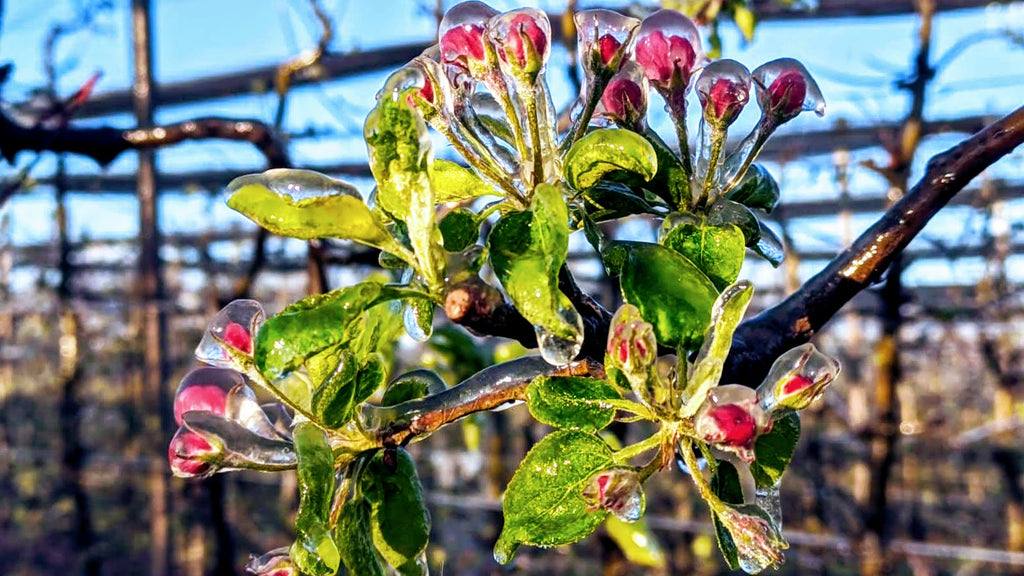
Principles of additive water freezing technology to create thin - walled ice crystal structures Analysis and influence of icing parameters on the thickness and transparency of the protective ice structure for the purpose of developing frost protection systems
Abstract:
Analysis of climate change and monitoring of the production cycle of outdoor food production in the past 5 years indicate the occurrence of early spring frosts as a phenomenon that significantly affects the yield. The onset of frost mostly results in the loss of the complete crop for the upcoming season, and even the insurance of the genus does not cover all the losses. Therefore, it is necessary to apply active protection measures and reduce the risk of food production. One such protective measure is the system of protection against frost (rain), which is based on the phenomenon of water anomaly, when energy is released during the change from liquid to solid state of water. This energy is used to maintain the temperature of the flower and young fruit in the range of 0 to 2 ° C. During such protection of plantations, ice crust is formed over the flower and fruit, whose temperature is 0 ° C. This ice protects the plantation with a needle effect (ideal insulator). Modern protection systems apply the technology of creating fully saturated air (100% relative humidity) within the protected microclimate, which results in significant savings in the required amount of water during protection, thus eliminating evaporation and saving energy needed to maintain thin-walled ice crystal structures at 0 ° C. Further advances in technology require a dynamic model of operation of systems with variable water rainfall intensity depending on current weather conditions. The reason for this is the need to maintain the crystal structure of the ice (transparent ice) with optimal water consumption throughout the night to ensure protection of the fruit from negative outside temperatures. Parameters that could affect the crystal structure of ice are temperature, humidity, wind and the intensity of water dripping with the size of droplets. The main goal of this research is to analyze the influence of water freezing parameters on the thickness and transparency of the protective ice structure. The obtained results would be the basis for the development of advanced management of frost protection system and the development of new types of sprinklers with variable rainfall intensity.
Keywords:
insulator, rain, crystal ice, latent heat, frost protection system, water

Overview of previous works:
Rainwater irrigation systems have been present for the last 50 years in use as frost protection systems but have not been commercially available for wider application as they are themselves large consumers of water and energy. Transport capacities and the power required to operate the system (pump) are also inaccessible to the average food producer. Conventional frost protection systems consume an average of 4 to 8 liters / m2 water and are used mainly for the protection of intensive apple and pear orchards. The reason for this is that freezing a large amount of water during a long period of work creates a thick and heavy layer of ice that causes mechanical damage inside the plantations. There is mechanical damage to flowers and fruits and even cracking of branches due to the weight of ice [1]. A study of the literature did not find the analysis and impact of rainwater systems with 100% relative humidity within the microclimate of plantations. The efficiency of such a system on larger areas (above 50,000 m) was confirmed by word of mouth from the technology integrator2) due to the creation of a separate energy microclimate. Integrators state efficient operation of systems with flows from 1 to 2 liters / m2 water. These data provide a basis for detailed research especially as thin-shell ice crystal structures are formed with better temperature properties than in conventional systems. The thermal conductivity of ice is 2.2 W / mK and cannot be included in the category of good insulators. In spite of this, the ice that is at the transition point between the liquid and solid aggregate phase, "wet ice" is at 0 ° C and therefore works as an ideal insulation limit for heat transfer. The described heat transfer during protection would be that on the one hand there is a negative impact of external temperature that falls sharply on the external contact surface of the thin-shell crystalline ice structure where there is continuous icing and new water dew. Under ideal conditions, the ice that freezes maintains a temperature of 0 ° C throughout its thickness and remains crystal clear without any irregularities in the crystal structure. Beneath the crystal structure on the contact surface between the ice and the fruit is a wet water film that ensures that the fruit tissue does not freeze. Any freezing of the tissue results in deformation or loss of fruit quality [2]. A computer model of frost simulation has been given in previous works [3] and it is an excellent basis for the development of a further model of frost protection system management. The paper precisely defines the need for energy depending on the micro-location and shape of plantations and the changing influence of climate. Extending the model to include active frost protection in the form of a rainwater system would be a significant advance for global food production. The assumption is that during optimal icing conditions, a regular square crystal structure is created [4]. Verification of this assumption can be proved by imaging ice structures during the protection of plantations from frost by X-ray, which is explained in this paper. [5] and using a microscope [6], both methods need to be considered in order to be able to conduct a survey of the crystal structure within the protected microclimate of the plantation itself. If the crystallization results are expected, the icing model could be used for application in the additive technology of 3D printing by water freezing, which is explained in the following paper [7]. The difference is that 3D conditions used dry atmosphere conditions to control the icing structure while in this study simulation of icing at 100% relative humidity of the laboratory setup was simulated. In conclusion, the crystal structure of ice has a significant impact in frost protection systems as well as for other technical applications. Targeted water freezing with parameters copied from the actual conditions of the frost protection system and proving the formation of a crystal structure would be a significant scientific breakthrough.

